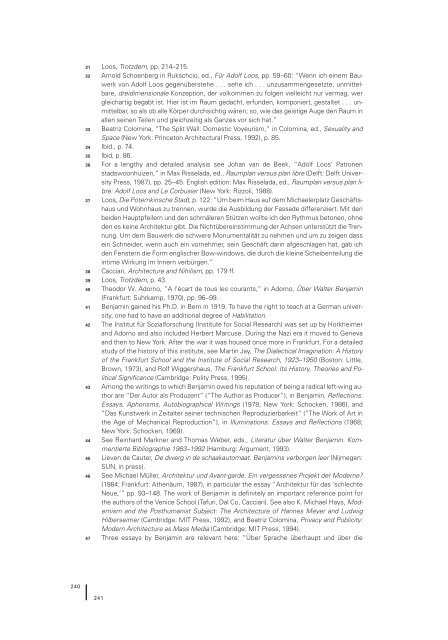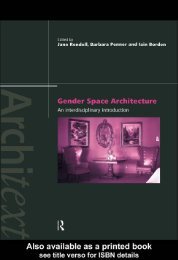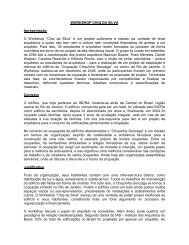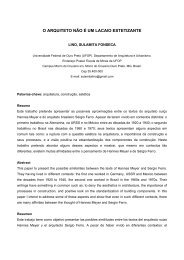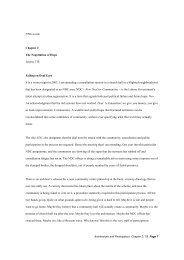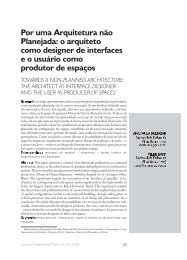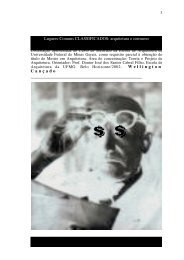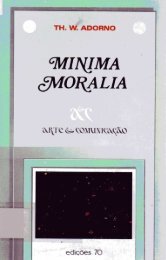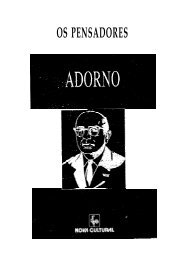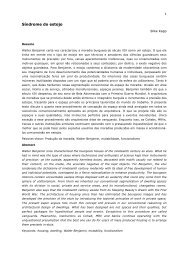Architecture and Modernity : A Critique
Architecture and Modernity : A Critique
Architecture and Modernity : A Critique
You also want an ePaper? Increase the reach of your titles
YUMPU automatically turns print PDFs into web optimized ePapers that Google loves.
240<br />
31 Loos, Trotzdem, pp. 214–215.<br />
32 Arnold Schoenberg in Rukschcio, ed., Für Adolf Loos, pp. 59–60: “Wenn ich einem Bauwerk<br />
von Adolf Loos gegenüberstehe . . . sehe ich . . . unzusammengesetzte, unmittelbare,<br />
dreidimensionale Konzeption, der volkommen zu folgen vielleicht nur vermag, wer<br />
gleichartig begabt ist. Hier ist im Raum gedacht, erfunden, komponiert, gestaltet . . . unmittelbar,<br />
so als ob alle Körper durchsichtig wären; so, wie das geistige Auge den Raum in<br />
allen seinen Teilen und gleichzeitig als Ganzes vor sich hat.”<br />
33 Beatriz Colomina, “The Split Wall: Domestic Voyeurism,” in Colomina, ed., Sexuality <strong>and</strong><br />
Space (New York: Princeton Architectural Press, 1992), p. 85.<br />
34 Ibid., p. 74.<br />
35 Ibid, p. 86.<br />
36 For a lengthy <strong>and</strong> detailed analysis see Johan van de Beek, “Adolf Loos’ Patronen<br />
stadswoonhuizen,” in Max Risselada, ed., Raumplan versus plan libre (Delft: Delft University<br />
Press, 1987), pp. 25–45. English edition: Max Risselada, ed., Raumplan versus plan libre:<br />
Adolf Loos <strong>and</strong> Le Corbusier (New York: Rizzoli, 1988).<br />
37 Loos, Die Potemkinsche Stadt, p. 122: “Um beim Haus auf dem Michaelerplatz Geschäftshaus<br />
und Wohnhaus zu trennen, wurde die Ausbildung der Fassade differenziert. Mit den<br />
beiden Hauptpfeilern und den schmäleren Stützen wollte ich den Rythmus betonen, ohne<br />
den es keine Architektur gibt. Die Nichtübereinstimmung der Achsen unterstützt die Trennung.<br />
Um dem Bauwerk die schwere Monumentalität zu nehmen und um zu zeigen dass<br />
ein Schneider, wenn auch ein vornehmer, sein Geschäft darin afgeschlagen hat, gab ich<br />
den Fenstern die Form englischer Bow-windows, die durch die kleine Scheibenteilung die<br />
intime Wirkung im Innern verbürgen.”<br />
38 Cacciari, <strong>Architecture</strong> <strong>and</strong> Nihilism, pp. 179 ff.<br />
39 Loos, Trotzdem, p. 43.<br />
40 Theodor W. Adorno, “A l’écart de tous les courants,” in Adorno, Über Walter Benjamin<br />
(Frankfurt: Suhrkamp, 1970), pp. 96–99.<br />
41 Benjamin gained his Ph.D. in Bern in 1919. To have the right to teach at a German university,<br />
one had to have an additional degree of Habilitation.<br />
42 The Institut für Sozialforschung (Institute for Social Research) was set up by Horkheimer<br />
<strong>and</strong> Adorno <strong>and</strong> also included Herbert Marcuse. During the Nazi era it moved to Geneva<br />
<strong>and</strong> then to New York. After the war it was housed once more in Frankfurt. For a detailed<br />
study of the history of this institute, see Martin Jay, The Dialectical Imagination: A History<br />
of the Frankfurt School <strong>and</strong> the Institute of Social Research, 1923–1950 (Boston: Little,<br />
Brown, 1973), <strong>and</strong> Rolf Wiggershaus, The Frankfurt School: Its History, Theories <strong>and</strong> Political<br />
Significance (Cambridge: Polity Press, 1995).<br />
43 Among the writings to which Benjamin owed his reputation of being a radical left-wing author<br />
are “Der Autor als Produzent” (“The Author as Producer”), in Benjamin, Reflections:<br />
Essays, Aphorisms, Autobiographical Writings (1978; New York: Schocken, 1986), <strong>and</strong><br />
“Das Kunstwerk in Zeitalter seiner technischen Reproduzierbarkeit” (“The Work of Art in<br />
the Age of Mechanical Reproduction”), in Illuminations: Essays <strong>and</strong> Reflections (1968;<br />
New York: Schocken, 1969).<br />
44 See Reinhard Markner <strong>and</strong> Thomas Weber, eds., Literatur über Walter Benjamin. Kommentierte<br />
Bibliographie 1983–1992 (Hamburg: Argument, 1993).<br />
45 Lieven de Cauter, De dwerg in de schaakautomaat. Benjamins verborgen leer (Nijmegen:<br />
SUN, in press).<br />
46 See Michael Müller, Architektur und Avant-garde. Ein vergessenes Projekt der Moderne?<br />
(1984; Frankfurt: Athenäum, 1987), in particular the essay “Architektur für das ‘schlechte<br />
Neue,’” pp. 93–148. The work of Benjamin is definitely an important reference point for<br />
the authors of the Venice School (Tafuri, Dal Co, Cacciari). See also K. Michael Hays, Modernism<br />
<strong>and</strong> the Posthumanist Subject: The <strong>Architecture</strong> of Hannes Meyer <strong>and</strong> Ludwig<br />
Hilberseimer (Cambridge: MIT Press, 1992), <strong>and</strong> Beatriz Colomina, Privacy <strong>and</strong> Publicity:<br />
Modern <strong>Architecture</strong> as Mass Media (Cambridge: MIT Press, 1994).<br />
47 Three essays by Benjamin are relevant here: “Über Sprache überhaupt und über die<br />
241


